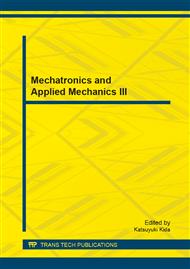[1]
Wang guoye, Liu Zhaodu, Cui Haifeng and Wu Lijun. Stepped Control in Comering Braking for ABS-equipped Vehicles. [J] Automotive Engineering. Vol 28 No. 11 (2006).
Google Scholar
[2]
Niu Shifeng. Research on Traffic Safety Characteristics of Curved Section of Highway[D]. Changchun: Jilin University (2008).
Google Scholar
[3]
Yoshihiro Okada, Takahide Nouzawa, Satoshi Okamoto, Takuya Fujita and Takashi Kamioka. Unsteady Vehicle Aerodynamics during a Dynamic Steering Action: 1st Report, On- Road Analysis. SAE Paper 2012-01-0446.
DOI: 10.4271/2012-01-0446
Google Scholar
[4]
Makoto Tsubokura and Yuki Ikawa. Unsteady Vehicle Aerodynamics during a Dynamic Steering Action: 2nd Report, Numerical Analysis. SAE Paper 2012-01-0448.
DOI: 10.4271/2012-01-0448
Google Scholar
[5]
Geoffrey M. Le Good and Kevin P. Garry. On the Use of Reference Models in Automotive Aerodynamics. SAE Paper 2004-01-1308.
DOI: 10.4271/2004-01-1308
Google Scholar
[6]
Tsuneaki Ishima, Yasushi Takahashi, Haruki Okado and Yasukazu Baba. 3D-PIV Measurement and Visualization of Streamlines Around a Standard SAE Vehicle Model. SAE Paper 2011-01-0161.
DOI: 10.4271/2011-01-0161
Google Scholar
[7]
Kevin P. Garry and Geoffrey M. Le Good. An Investigation of the Sensitivity of Rear Wing Orientation for Saloon Race Cars. SAE Paper 2005-01-1018.
DOI: 10.4271/2005-01-1018
Google Scholar
[8]
David Schrock, Nils Widdecke and Jochen Wiedemann. The Effect of High Turbulence Intensities on Surface Pressure Fluctuations and Wake Structures of a Vehicle Model. SAE Paper 2009-01-0001.
DOI: 10.4271/2009-01-0001
Google Scholar
[9]
Kapadia S, Roy S. Detached eddy simulation over a reference Ahmed car model[C]. AIAA Paper 2003-0857.
DOI: 10.2514/6.2003-857
Google Scholar
[10]
Asya Gabbasa and Badih Ali Jawad. CFD-Based Shape Optimization for Optimal Aerodynamic Design. SAE Paper 2012-01-0507.
Google Scholar
[11]
Wang FUjun. The Analysis of Computational Fluid Dynamics [M]. Bejing: Tsinghua University Press, (2004).
Google Scholar
[12]
Fluent Inc. FLUENT user's guide[M]. Fluent Inc., (2003).
Google Scholar
[13]
E. Guilmineau and F. Chometon. Experimental and Numerical Analysis of the Effect of Side Wind on a Simplified Car Mode. SAE Paper 2007-01-0108.
DOI: 10.4271/2007-01-0108
Google Scholar
[14]
Mao Jia-chuan. Effect of driving width of bends on track and speed of passenger car [J]. Journal of Transport Science and Engineering. Vol. 27 No. 4 (2011).
Google Scholar
[15]
Wang jingyu, hu xingjun and zhang zhi. Research of Lane-changed Overtaking Based on Overlapping Grid. ICCAHE Paper 2012. 8.
Google Scholar


